How much do you know about thermal gel (heat dissipation gel) ? What is it and where to apply?
Here is the outline:
What is thermal gel?
What are the characteristics of thermal gel?
Application of thermal gel
What will happen to the thermal gel during the application process?
Compared with thermal pads and thermal grease, what are the advantages and disadvantages of thermal gel?
Why choose thermal gel?
What is thermal gel?
Thermal gel (also known as thermal conductive gel, heat sink gel, CPU gel and processor gel ect.) is a gel-like silicone based thermally conductive material formed by stirring, mixing and encapsulating silicone resin, crosslinking agent, thermally conductive filler and curing agent.
It has one part and two parts thermal conductive silicone gel. Among them, the two-component thermal gel is divided into A and B components. The A component is composed of silicone resin, crosslinking agent and filler, and the B component is composed of silicone resin, catalyst and filler. After the two are mixed and cured, it will become thermal silica gel.
What are the characteristics of thermal gel?
Thermally conductive gel has almost no hardness, is soft and has a strong surface affinity. It can be compressed into a very thin variety of shapes and spread on the surface of various types of non-smooth electronic components, significantly improving the heat transfer efficiency of electronic components.
Thermally conductive gel has viscosity and adhesion, will not be oily and dry, and has very superior reliability.
Thermal gel has a weak adhesion to the surface of the substrate and can be peeled off from the substrate. Therefore, the electronic components filled with it are reworkable.
Application of thermal gel
Thermal conductive gel is widely used in LED chips, communication equipment, CPU and other semiconductor fields.
It is applied to the contact surface between the heating element (power tube, thyristor, electric heating pile, etc.) in various electronic products and electrical equipment and the heat dissipation facility (heat sink, shell) to transfer heat Intermediate action and moisture-proof, dust-proof, anti-corrosion, anti-vibration and other properties.
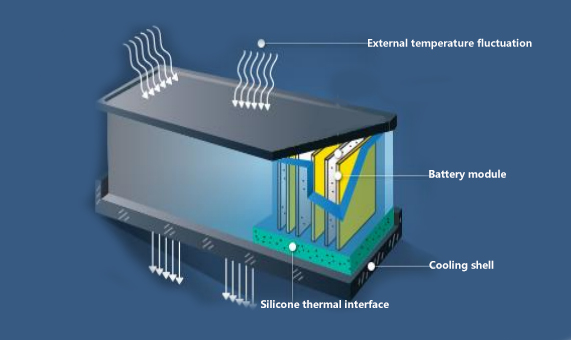 What will happen to the thermal gel during the application process?
What will happen to the thermal gel during the application process?
Since thermal gel has a large proportion of thermally conductive fillers and the viscosity of the rubber is high, the thermal conductive gel is prone to air bubbles during the production and packaging of the rubber tube. The generation of bubbles will cause the rubber to solidify and form a cavity, which affects the appearance of heat transfer gel and reduce the thermal conductivity.
If there are bubbles in one component of the two-component thermal gel, it will also affect the mixing ratio of the AB glue and affect the performance of all aspects of the product.
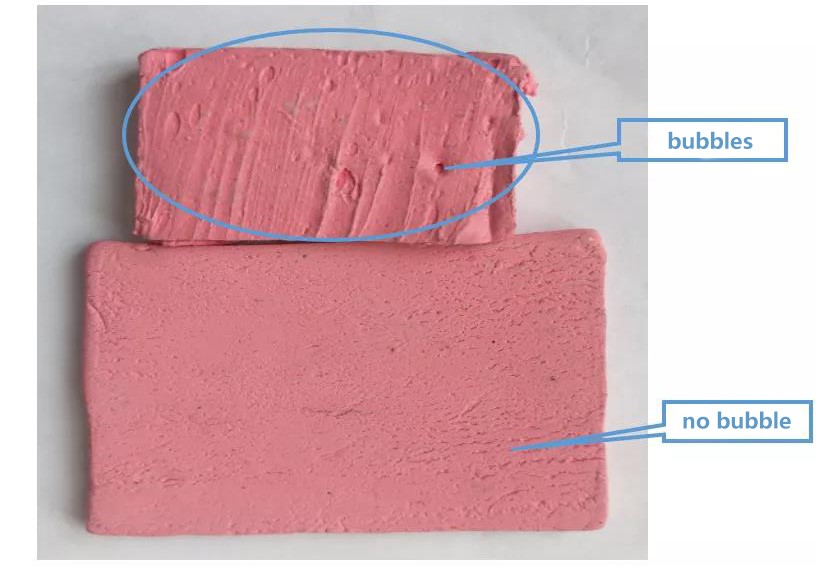
During the dispensing test of thermal conductive gel, if the glue outlet is too small, the extrusion pressure or the viscosity of the heat conductive gel are too high, the glue will overflow from the end of the hose. One of the main reasons is that in the process of squeezing the glue by the tail cover, the glue also reversely squeezes the tail cover. When the pressure is too high, the tail cover cannot withstand the deformation and overflows. the second is that the gel thermal squeezes the packaging tube which causes the packaging tube to deform and overflow.
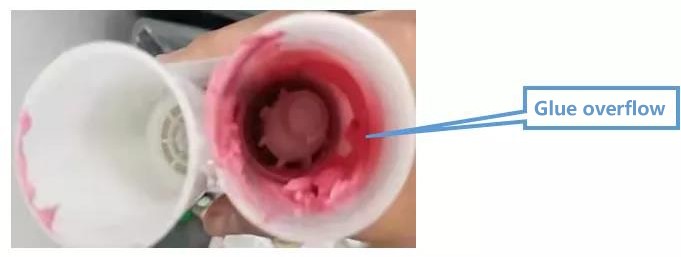
Before the two-component thermal gel is cured, the components in the AB tube are mainly a combination of oil and powder. When the oil and powder are not well combined, they are very easy to stratify (separate out.) resulting in the upper and lower parts of the processor gel are not uniform, and oil is prone to appear.
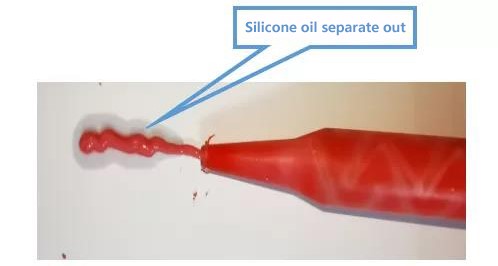 Note:
Note:
When the A+B components are mixed and cured into a gel, the silicone oil and the cross-linking agent react to form a tight spatial network structure, and the product hardly produces oil at this time.
Compared with thermal pads and thermal grease (Thermal paste), what are the advantages and disadvantages of thermal gel?
Thermal gel belongs to thermal interface materials (TIM) like thermal paste and thermal pad.
Thermal gel:
Advantages:
- It can be compressed into various shapes, and the minimum can be compressed to a few hundred microns, which reduces the thermal resistance of the gel and improves the heat transfer efficiency of the electronic element;
- Can use dispenser for continuous operation;
- Will not oil and dry
Disadvantage:
The powder filling amount is limited, and the current maximum can reach 6w/m.k.
Thermal pad:
Advantages:
- The highest thermal conductivity, can achieve 10-20 w/m.k
- Can be made into various shapes;
Disadvantages:
- Each shape requires a specific mold;
- Unable to operate continuously, it is necessary to use each gasket to bond the electronic components, it is easy to wrinkle and produce cavities during the bonding process, and the operation process is complicated
Thermal grease:
Advantages:
- It can be printed on screen or steel plate, or painted directly, which is easy to operate
- The operation can be continuous.
- The amount of glue is the thinnest and can be brushed into a few microns
Disadvantages:
- Easily oily and dry, long-term stability and reliability are insufficient;
- The thermal conductivity of silicone grease is not much different from that of thermal gel, which is much lower than that of thermal pad
Why choose thermal gel?
The most serious problem of thermal conductive silicone grease is the precipitation of silicone oil after long-term use. However, the precipitation of silicone oil will cause short-circuit failure of surrounding electronic devices, and at the same time, the thermal conductivity will drop sharply
Although the thermal pad has a long service life, it has a high thermal resistance and requires a higher working pressure.
Thermal gel combines the advantages of thermal grease and thermal pad, while avoiding the shortcomings of both. Thermal conductive gel is a silicone grease mixed with high thermal conductivity particles (such as alumina, silver powder, etc.), and then through a heat treatment process to cross-link low-molecular-weight siloxane, and then form a gel.
Thermal gap filler is a gel state substance between liquid and solid. It not only has the characteristics of shape recovery, strong material cohesion, high heat resistance, good long-term thermal stability and etc., but also has extremely low thermal resistance like thermal conductive silicone grease that can fill gaps, and has high adhesion.
Antas two-component thermal gel product model
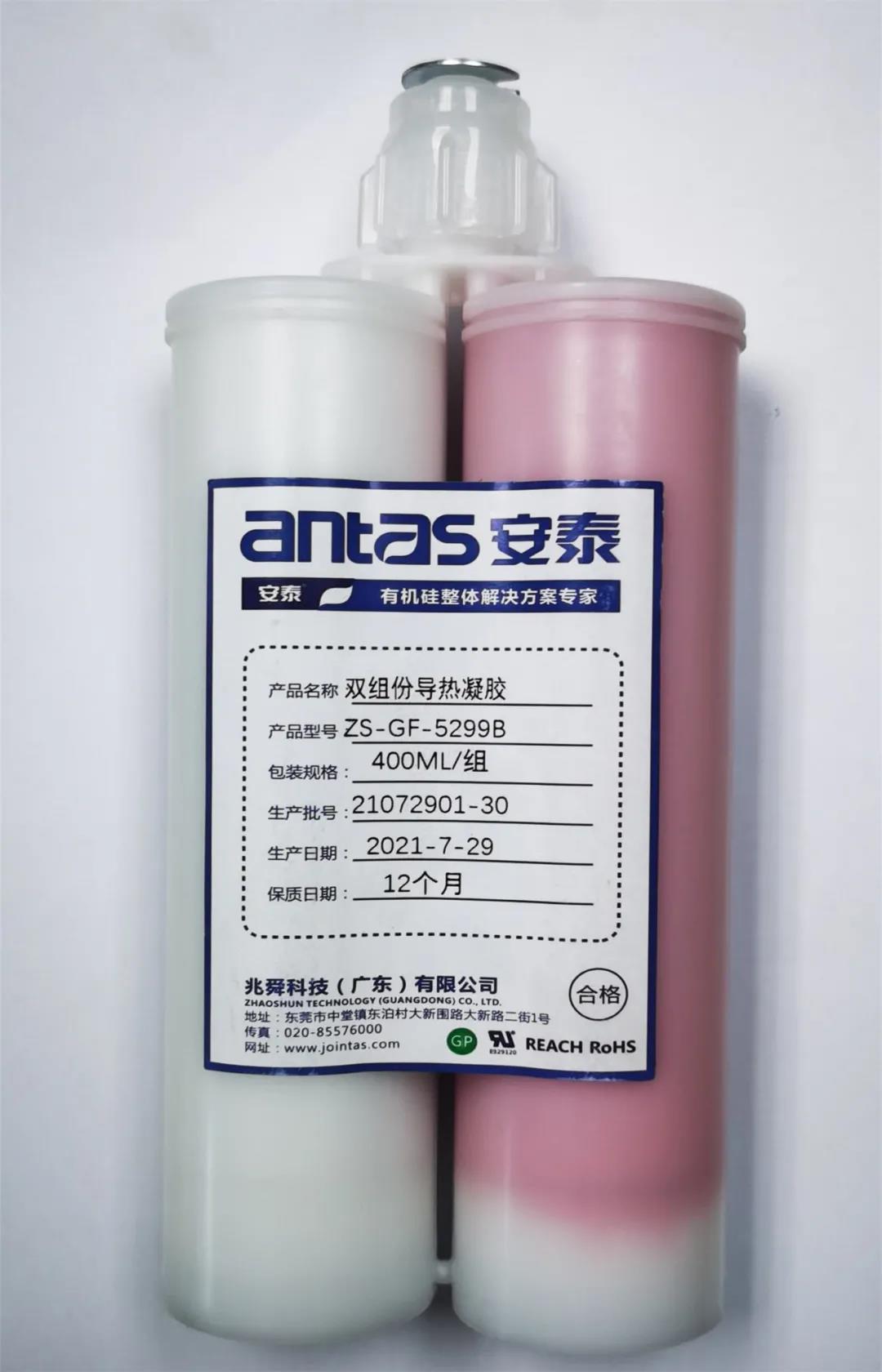
 ZS-GF-5299B heat dissipation gel
ZS-GF-5299B heat dissipation gel is a kind of paste-like two-component addition molding high thermally conductivity silicone gel, which can be cured by heating, and has the characteristic that the higher the temperature, the faster the curing.
This thermal gap filler does not produce any by-products in the curing reaction. It is suitable for PC, PP, ABS, PVC and other materials and metal surfaces and It can be used in an environment of -40°C to 200°C and fully meets the requirements of EU ROHS and REACH directives.
Jointas chemical is listed company specialized in R&D, manufacture and sale of Eco-friendly silicone sealant, thermal gel, thermal grease and water based paints&coatings founded in 1989, China. Get FREE sample to test the quality now! Email:oversea@jointas.com






